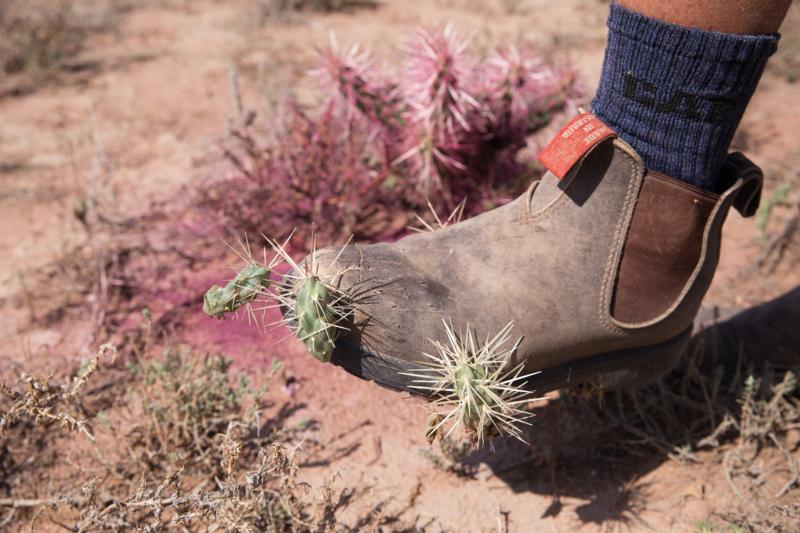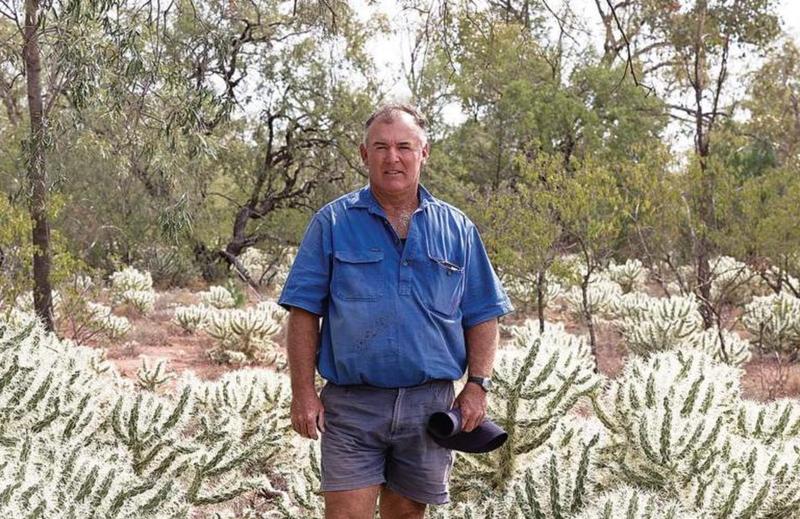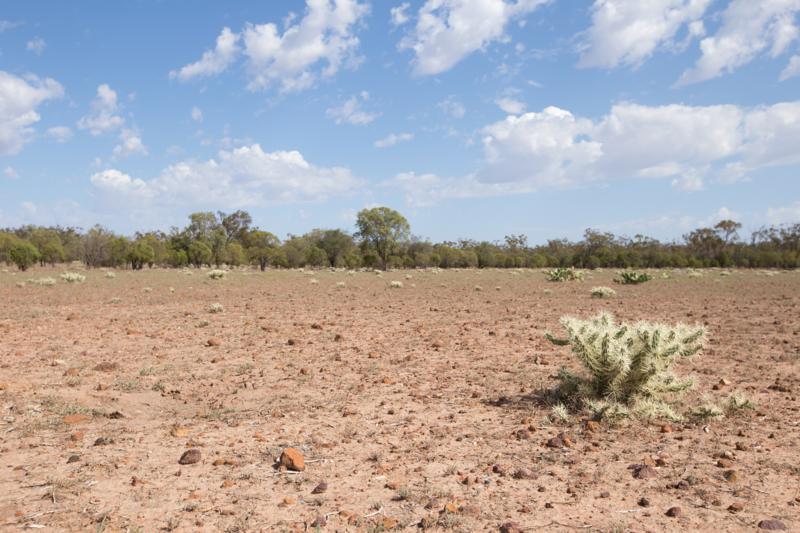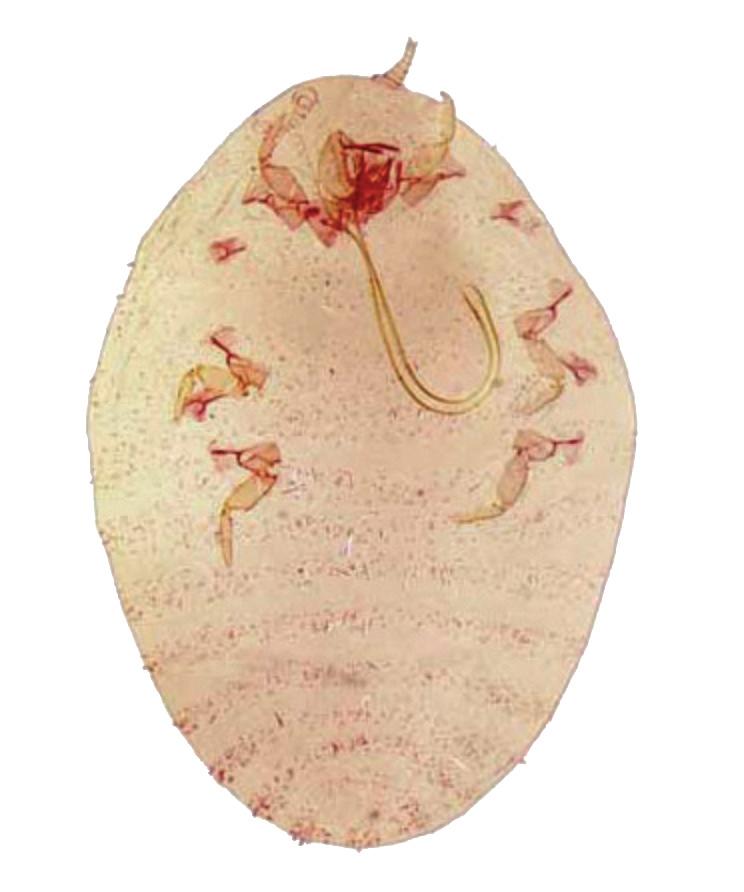WITH its Triffid-like prolific growth and barbed spikes that snare any creature unfortunate enough to walk into it, Hudson pear is like something out of a horror movie. But as farmers valiantly continue to battle this Mexican prickly invader, finally there’s a new weapon in their armoury.
Neil Warden still winces as he recalls the excruciating pain of treading on a segment of Hudson pear. The barbed spike went straight through his boot and embedded itself in his flesh. “I ended up having to cut my boot off,” he says. “I couldn’t slip my foot out.”
It’s not the only painful encounter the farmer from Cumborah, near Walgett in North West NSW, has had with the noxious weed, which is native to Mexico and was first noticed on the loose in Australia in the 1960s. One of his goats starved to death after becoming impaled on the cactus.
He’s also seen shearers with spikes in their legs that have been transferred via a fleece. They can only be removed with pliers and, when they come out, the barbs bring a plug of flesh with them.
HUDSON PEAR – AN EXPENSIVE ENEMY
So desperate is Neil to stop Hudson pear rendering his land unusable, he has just ordered a custom-built sprayer to help him in his perpetual fight against the prickly invader. He expects the cost to be around $25,000 but believes it’ll be worth it. Despite regular spraying, at least 25% of his property is affected and over the past year the infestation has doubled.
 The plant attaches itself to Neil’s boot. 25% of Neil’s property is now affected and over the past year the infestation has doubled.
The plant attaches itself to Neil’s boot. 25% of Neil’s property is now affected and over the past year the infestation has doubled.
Neighbouring farmers have wearied of the losing battle – it only takes a 1cm segment of Hudson pear to be carried onto Neil’s property by wind or native animals and, no matter how dry and sandy the soil, more plants spring up.
“They’re like Triffids, like something out of a horror movie,” observes another Cumborah grazier, Jon Pocknell. “It’s the worst weed I’ve ever known – and I’ve seen a few.”
Jon has been spraying every spring and autumn to keep on top of Hudson pear, doubling his regime over the past two years on the 40 hectares closest to his house, managing a 99.9% kill rate.
“I went back and used another 30 litres on the little plants that had come back. It’s unbelievable how tough it is.”
LANDOWNERS VOLUNTEER WITH HERBICIDE
Jon is part of a volunteer group of 12 local landholders who get together every month to help spray other properties. Some of these volunteers don’t even have Hudson pear on their land but they want to keep it that way.
Their meticulous attention to detail – 100% cover, spraying a 60cm-wide radius from the plant and using an oil to help spread the chemical over the fast-growing weed – is essential or the herbicide can make the problem worse.
Hudson pear has a waxy outer so if insufficient herbicide is applied, it merely falls apart but doesn’t die. The small segments lie in the grass and there’s an 80% viability of each one becoming a new plant.
Jon has areas of land where he dares not run his dogs for fear they’ll get the spikes in their paws and noses. He watches with a mixture of despair and empathy as neighbouring farmers simply give up the fight, leaving grazing land completely useless and unsaleable.
He says some infestations are so dense, with Hudson pear growing up to 1.5m tall, that if you went into one of the affected areas on a motorbike and fell and snared yourself on one of the plants, it’s possible no-one would find you.
Indeed, there has already been one human fatality recorded – a miner who fell onto a plant and, writhing in agony, suffered heart failure.
LOOKING TO BIOCONTROL MEASURES – IS THIS SUPERBUG THE ANSWER?
Like other farmers in the Cumborah, Grawin and Lightning Ridge areas of North West NSW, Neil and Jon are now pinning their hopes on a new biological control for Hudson pear (Cylindropuntia rosea) – a cochineal bug which, as The Farmer went to press, was making its first forays into core infestations.
 Neil Warren among the Hudson pear on his Cumborah property.
Neil Warren among the Hudson pear on his Cumborah property.
In the meantime, North West Local Land Services (LLS) has been holding community meetings to prepare landholders and local miners for the biocontrol and to ensure they have the best integrated strategy – with the bug released in core infestations and herbicides used to keep the spread along fence lines and outlying areas under control.
“We’ll work out how quickly they kill the plants and how fast that spread is, then use that information to guide landholders,” explains Dr Andrew McConnachie, a research officer in the Weed Research Unit (Biosecurity) of the NSW Department of Primary Industries.
“The herbicide is quicker but the bug is environmentally friendly. You don’t have off-target impacts as you do with herbicides and it’s self-sustaining, so once it’s in the field you don’t have to reapply.”
Adair Garemyn, NSW Farmers’ policy director – environment, says Hudson pear is a particularly vicious weed that is affecting many western farmers, in particular those around the Lightning Ridge area.
“Hudson pear is a serious threat to farm and livestock welfare, safety and biosecurity. We also have opal miners working on and across our properties so biosecurity risks are exacerbated.”
“We are calling for increased funding to tackle Hudson pear. We need coordinated, properly resourced control efforts where all parties and industries chip in. We are also strong supporters of the continuation of research and roll-out of biological control means.”
*READ about how Sorghum farmers in NSW and Queensland are suing for
damages after buying bags of seeds allegedly contaminated
with the noxious weed shattercane.
*READ about how Sorghum farmers in NSW and Queensland are suing for
damages after buying bags of seeds allegedly contaminated
with the noxious weed shattercane.
AT CRISIS POINT – ACTING TO PREVENT FURTHER DAMAGE FROM HUDSON PEAR
So how did the problem arise? It’s believed that the Mexican plant “escaped” from a cactus nursery in Grawin. In the past 10 years, infestation has reached crisis point and, says Lightning Ridge farmer Wayne Newton, the release of the bug can’t happen soon enough.
He’s seen countless native birds and animals perish as they struggle to free themselves from the plant. “Imagine a child falling into one of those things,” he says with a shudder.
Like others in the area, he fears that the Hudson pear will make its way into the Big Warrambool or Narran rivers and from there to the Murray-Darling Basin, causing massive issues for the community at large throughout NSW, Victoria and South Australia.
 Over the last 10 years, Hudson pear infestation has reached crisis point in North West NSW.
Over the last 10 years, Hudson pear infestation has reached crisis point in North West NSW.
Wayne also wants to see a coordinator appointed to ensure an ongoing multi-pronged approach to control. A cost-benefit analysis and application by the LLS for a $7 million, 10-year program that would pay for such a post is currently with NSW Treasury.
This would also pay for mapping priority areas, spraying and setting up mass-rearing facilities for the biocontrol as well as education and community engagement programs for issues such as best practice for moving vehicles – the spikes easily embed themselves in tyres and increase spread – and stressing the importance for all landholders to participate.
If the program is sufficiently funded, the LLS reckons it can aim to reduce the initial infestation to just 0.01%. If it isn’t and Hudson pear spreads, the LLS has calculated the cost to NSW at $536 million – with grazing land and community facilities rendered useless and biodiversity under threat.
HOW COCHINEAL BUG MAY BE THE ANSWER TO BIODIVERSITY THREAT
The cochineal bug that is being released to control Hudson pear is the same species but different biotype to the Dactylopius tomentosus bug that was released in 1925 and proved safe and effective against Devil’s rope pear, says Dr Andrew McConnachie of the NSW Department of Primary Industries. He’s quietly confident that the bug, Dactylopius tomentosus ‘californica var. parkeri’, will be effective against Hudson pear.
 The cochineal bug that is being released to control Hudson pear.
The cochineal bug that is being released to control Hudson pear.
“At two monitoring sites we’ve had almost 100% control in a one-hectare area,” he says. “The bug is highly specific to Hudson pear, it doesn’t damage or kill other plants and it works by the female inserting her mouthpart into the cladode of the cactus.
Unable to retract, she stays there and there’s a theory her saliva is toxic to the plant, but there is also damage caused by the female taking nutrients from the plant.
“She then covers herself with a waxy covering and lays hundreds of eggs. When the babies hatch they move to the tips of the cactus from where they are blown to other Hudson pear and the cycle continues.”
Obviously, the bug is not a silver bullet. In laboratory conditions it takes about 16 weeks for one female to kill one plant. Researchers don’t know what control rates will be once large numbers are released in the field but it’s likely to take months to have a serious impact.
The project is supported by funding from the federal Department of Agriculture and Water Resources as part of its Rural Research and Development for Profit program.
*READ more about Australia’s top biosecurity concerns:
- Kicking up a stink: What’s bugging our biosecurity experts?